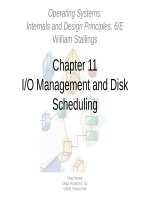Lecture Operating systems Internals and design principles (6 E) Chapter 12 William Stallings
Bạn đang xem bản rút gọn của tài liệu. Xem và tải ngay bản đầy đủ của tài liệu tại đây (600.93 KB, 104 trang )
Operating Systems:
Internals and Design Principles, 6/E
William Stallings
Chapter 12
File Management
Roadmap
• Overview
•
•
•
•
•
•
•
•
•
File organisation and Access
File Directories
File Sharing
Record Blocking
Secondary Storage Management
File System Security
Unix File Management
Linux Virtual File System
Windows File System
Files
• Files are the central element to most
applications
• The File System is one of the most
important part of the OS to a user
• Desirable properties of files:
– Long-term existence
– Sharable between processes
– Structure
File Management
• File management system consists of
system utility programs that run as
privileged applications
• Concerned with secondary storage
Typical Operations
• File systems also provide functions which
can be performed on files, typically:
– Create
– Delete
– Open
– Close
– Read
– Write
Terms
• Four terms are in common use when
discussing files:
– Field
– Record
– File
– Database
Fields and Records
• Fields
– Basic element of data
– Contains a single value
– Characterized by its length and data type
• Records
– Collection of related fields
– Treated as a unit
File and Database
• File
– Have file names
– Is a collection of similar records
– Treated as a single entity
– May implement access control mechanisms
• Database
– Collection of related data
– Relationships exist among elements
– Consists of one or more files
File
Management Systems
• Provides services to users and
applications in the use of files
– The way a user or application accesses files
• Programmer does not need to develop file
management software
Objectives for a File
Management System
•
•
•
•
Meet the data management needs of the user
Guarantee that the data in the file are valid
Optimize performance
Provide I/O support for a variety of storage
device types
• Minimize lost or destroyed data
• Provide a standardized set of I/O interface
routines to user processes
• Provide I/O support for multiple users (if needed)
Requirements for a
general purpose system
1. Each user should be able to create,
delete, read, write and modify files
2. Each user may have controlled access to
other users’ files
3. Each user may control what type of
accesses are allowed to the users’ files
4. Each user should be able to restructure
the user’s files in a form appropriate to
the problem
Requirements cont.
5. Each user should be able to move data
between files
6. Each user should be able to back up and
recover the user’s files in case of damage
7. Each user should be able to access the
user’s files by using symbolic names
Typical software
organization
Device Drivers
• Lowest level
• Communicates directly with peripheral
devices
• Responsible for starting I/O operations on
a device
• Processes the completion of an I/O
request
Basic File System
• Physical I/O
• Primary interface with the environment
outside the computer system
• Deals with exchanging blocks of data
• Concerned with the placement of blocks
• Concerned with buffering blocks in main
memory
Basic I/O Supervisor
• Responsible for all file I/O initiation and
termination.
• Control structures deal with
• Device I/O,
• Scheduling,
• File status.
• Selects and schedules I/O with the device
Logical I/O
• Enables users and applications to access
records
• Provides general-purpose record I/O
capability
• Maintains basic data about file
Access Method
• Closest to the user
• Reflect different file structures
• Provides a standard interface between
applications and the file systems and
devices that hold the data
• Access method varies depending on the
ways to access and process data for the
device.
Elements of
File Management
Roadmap
• Overview
• File organisation and Access
•
•
•
•
•
•
•
•
File Directories
File Sharing
Record Blocking
Secondary Storage Management
File System Security
Unix File Management
Linux Virtual File System
Windows File System
File Organization
• File Management Referring to the logical
structure of records
– Physical organization discussed later
• Determined by the way in which files are
accessed
Criteria for
File Organization
• Important criteria include:
– Short access time
– Ease of update
– Economy of storage
– Simple maintenance
– Reliability
• Priority will differ depending on the use
(e.g. read-only CD vs Hard Drive)
– Some may even conflict
File Organisation
Types
• Many exist, but usually variations of:
– Pile
– Sequential file
– Indexed sequential file
– Indexed file
– Direct, or hashed, file
The Pile
• Data are collected in the order
they arrive
– No structure
• Purpose is to accumulate a
mass of data and save it
• Records may have different
fields
• Record access is by exhaustive
search
The Sequential File
• Fixed format used for records
• Records are the same length
• All fields the same (order and
length)
• Field names and lengths are
attributes of the file
• Key field
– Uniquely identifies the record
– Records are stored in key
sequence









